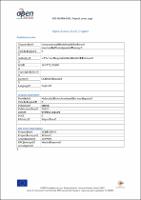Chapter 8 Computational Modelling of the Steps Involved in Photodynamic Therapy
Author(s)
Paterson, Martin J.
Bergendahl, L. Therese
Collection
European Research Council (ERC); EU collectionLanguage
EnglishAbstract
Photodynamic therapy (PDT) is a branch of phototherapy that has seen a surge of interest in the last few decades, due to its potential in the treatment of various cancers, infections and
heart disease.(Bonnett, 2000) This chapter aims to give an overview of the various
photochemical steps involved in PDT as a cancer therapy, and in particular the challenges
and insight gained from their theoretical description. After a brief review of PDT in general,
in a biological and chemical context, the photochemical steps involved will be discussed,
detailing the computational techniques required to model these chemical pathways
theoretically. We will detail the methodologies that can currently be applied, as well as their
limitations of use at present, and areas requiring further development.
Keywords
computational modelling; photodynamic therapy; computational modelling; photodynamic therapy; Electron; Excited state; Ground state; Molecule; Multi-configurational self-consistent field; Pacific Time Zone; Photosensitizer; Porphyrin; Wave functionDOI
10.5772/37654OCN
1030819927Publisher
InTechOpenPublisher website
https://www.intechopen.com/Publication date and place
2012Grantor
Classification
Science: general issues


 Download
Download